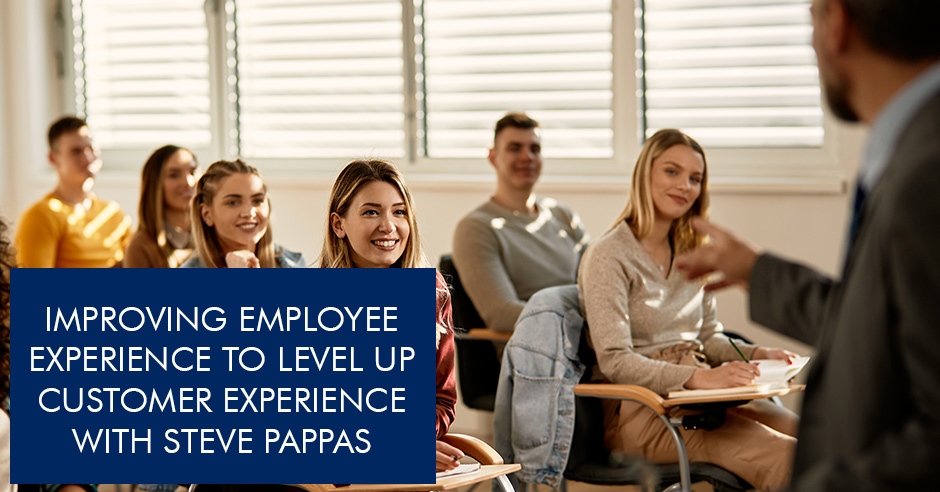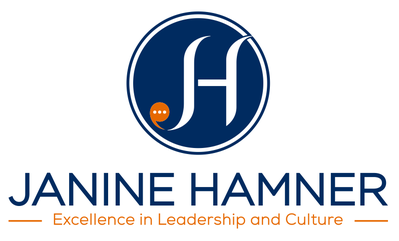
An effective business leader ensures the happiness of their team and constantly provides them with growth-oriented career opportunities. Outstanding employee experience leads to excellent customer experience, resulting in a rewarding organizational culture. Janine Hamner Holman sits down with Steve Pappas to dissect the intersection between employee and customer experiences, especially in today’s landscape vastly changed by technology and the pandemic. Steve shares his five tenets of effective business leadership, how to own up to your mistakes, and the best way to swim in a sea of uncertainty.
GUEST: Steve Pappas | LinkedIn | Visit their Website: www.scienceofcx.com
HOST: Janine Hamner Holman | [email protected] | LinkedIn, Facebook, Instagram, and Twitter
—
Listen to the podcast here
Improving Employee Experience to Level Up Customer Experience with Steve Pappas
What am I paying attention to in this episode? The layoffs that happened at Twitter and what that’s doing to both the employees and the culture of the organization. I was reading an article about how it used to be that the culture of the organization was that we are all people who care about getting the word of people and the actual truth out there and having a vibrant dialogue. That’s what we all care about. Now, literally, overnight, half the staff is gone. People who are remaining are terrified for their jobs that they are now sleeping in the office.
People inside the organization are saying, “We don’t know if the public is ever going to trust Twitter again. The organizational culture of the place that we have cared about for so long has been completely destroyed.” It’s gotten me thinking about this intersectionality between employee experience, customer experience, and organizational culture, which are topics our guest for this episode knows quite a lot about. I am excited to introduce you to Steve Pappas who I got to know a few years ago.
We were looking at exactly this intersection between employee experience, employee engagement, and customer experience. Steve has been called the CX Connoisseur, that’s the customer experience, and has spent many years in his relentless pursuit of building great customer experiences.
I’m thrilled to welcome you to the show, Steve.
Thanks, Janine. I have been looking forward to this. I can’t even tell you how long I have had it on my calendar and thought, “I can’t wait to talk to Janine.”
You know how you meet certain people along the way and think, “I don’t know where you have been all my life. I’m 100% sure you are going to stay in it.” I feel like we have been friends since we were seven kinds of connection. That’s how I feel.
That’s exactly the way it feels. It feels that the moment we started talking for the first time, I said, “That felt so natural. It felt like we were neighbors,” or something like that.
Juicy experiences, I love it. I’m going to start the way that I often start. Steve, what is something that you have become aware of that people are not paying enough attention to, either consciously or unconsciously? What’s the cost of that?
There are an awful lot of things that I’ve become more aware of that people are changing. Especially through the pandemic, people have changed the way they look at things. What’s also changed is their expectations of the way things should be. Whether that’s rooted in reality or not, the fact is that much of society’s way of looking at things has been changing. For a while there, during the pandemic, people seem to have a longer fuse but now, as we’ve started emerging, their fuses are getting much shorter. The response time that they were expecting was yesterday.
That flows through to a lot of different things, from how they drive on the road, how much faster they are driving, how many more risks they are willing to take, and how they are gambling with things. They’ve got to get somewhere. It’s almost like the pandemic caused more perpetual motion, especially in this country, to become part of everyone’s day-to-day routine.
They don’t even know what’s happening. It has been an evolution that’s happening around them. It’s like being on that hamster wheel, and they can’t get off it. They are not stopping long enough to look at the bigger picture. The blinders are on, and they are moving full steam ahead forward. If you are in their way, they are going through you or around you.
Over you. I had the opportunity to give a keynote talk for a group of organizational leaders for the County of San Diego. We got into this conversation about how the iPhone, which has become ubiquitous, has only been around since 2007. Obviously, we are all aging. There is this phenomenon that happens as we age, that time is speeding up. It also feels like time is speeding up in part because of this phenomenon that you were pointing to. For many of us, we wake up, and the first thing we do in the morning is check our phones. The pace of life has changed dramatically.
One of the things that is interesting and important for people like you and me who are focused on how to make organizations be the best that they can be is by focusing on the employees on my side and the customer experience on your side. It has changed what employees and customers expect. It has fundamentally changed the concept of what we expect from leaders and managers, the way that people expect to be treated and demand to be treated.
Steve and I were talking before we started recording. We are almost the same age. When we were coming up in the world of work, you put your head down and dealt with whatever nonsense was happening from your boss or the organization. We were dealt a good or a bad hand and played that hand.
In two and a half more years, 75% of the workforce will be Millennials and the Gen Zs who are coming up after them. The oldest Millennials are now 41 years old. These are not children anymore. They are willing to leave in a way that we never were, our generations never were, and the generations that came after us were never willing to walk out the door if we weren’t being treated the way that humans should be treated. Their intolerance for toxic environments or even for bad management is creating a sea change in the way that organizations need to look at leadership. I believe that the same is true for customer experience, in part because of that impatience that you were pointing to. What do you think of all that?
There’s a lot to unpack there. Let’s start with the pace. You talked about the pace of life moving at a ferocious pace now, the cost of that pace is that we are crashing. I don’t know if there’s anyone over the age of 35 that hasn’t complained about exhaustion and fatigue. What’s happening is their brains are being so occupied by the digital realm in one shape or another. They are getting tons of input in the course of a day which doesn’t allow them to come up for air. What’s happening is their brains are getting tired earlier in the day.
I don’t think they are realizing what the long-term cost is of all of this. We require so much input, it’s pushing us to stay in perpetual motion. There’s something happening all the time. If we are not getting that level of input all the time, we are bored or think something is wrong. That’s not the case. The case is that we need to get back to balance somehow. The balance doesn’t mean you are throwing away your smartphone and everything else. The balance means that you stop and take a minute for yourself in the course of a day.
Our brains are so occupied by the digital realm in one shape or another. Many don't realize that the long-term cost of this is that we require so much input, pushing us to stay in perpetual motion. Share on XYou talked about the workforce and the ones that are willing to say, “No. I’m out of here,” that’s probably the extreme side of, “How do I deal with this?” It may be an atmosphere that they could have dealt with. It could be something that would be fine, but when you layer all of the other things of life, what happens is you are creating this layered on effect. Maybe they are new parents, recent parents or have school-aged kids and were homeschooling and dealing with all of the other pressures that they went through in the course of the pandemic.
At some point, the human mind says, “Something’s got to give.” They try not to take it out on the people around them. They try not to take it out on themselves. They are probably not looking for healthy solutions like working out, learning a new hobby or something like that. Where does it come out? The workplace is probably the largest chunk of time and amount of effort and energy spent with others so it comes out in the workplace which means employee engagement levels start plummeting.
How can an unengaged employee ever create a great customer experience? They are thinking, “I’m leaving. I’m not happy. I don’t like this environment. The customer has a problem. I will let Janine handle it.” The customer experience goes down, too. The other side of it was that the pandemic resulted in a lot of change in general. We have dealt with change in almost every form we could possibly get thrown at us.

Employee Experience: An unengaged employee will have a hard time creating a great customer experience.
In a compressed timeframe.
None of us were prepared for how to deal with it. Nobody of any experience level came out during the pandemic had said, “You are probably feeling all of these things. Here’s what you need to do to get through it.” We didn’t get that. We got, “We are going to be still wearing masks. We are still going to be doing this. You got to get your booster shot.” It was more prescriptive than it was therapeutic for us.
Somebody asked me this question. They said, “What did you worry about? What kept you up at night?” My answer was, “I cared more about how my employees and their families were faring than I did my own family and my situation.” I was dealing with a lot. We were being acquired at the time. I was working almost two full-time jobs during that. I worried about what they were doing. I could still point to and pull out of these cabinets here all the trivia games I had bought, everything I could find to do trivia nights.
We did all kinds of things for every holiday. We were making gingerbread houses together on Zoom. We had Halloween parties with the kids on Zoom. We took old-time radio programs. Everybody got their own part. On Zoom, we all did Flash Gordon from the 1930s. We had a great Ming the Merciless and a great Flash Gordon. A friend of mine edited it all together. It was like a bad karate movie where the lips didn’t sink.
We roared when we did the unveiling with the virtual red carpet and everything. It was things like that. It was, from a management perspective, how much pain your employees are feeling and caring about them, their career, their career opportunities, their progression, their happiness, and making sure that they are okay.
How much, as a manager, do you care about that? During the pandemic, and some people relate to this, were you worried you weren’t getting the productivity out of people? I don’t have any statistics but I feel the productivity is between 40% and 50% now. That’s the old school. That’s the traditional manager. That’s the manager who had his head down, didn’t say anything, grew into a management position, and during the pandemic, was probably pretty untrusting.
Thus, the people you talked about who are willing to leave were probably, to some degree, under that type of manager, not more of a new style manager that said, “Let’s have fun. On Friday, we are going to get together at 4:00. We will knock off an hour early. Bring your favorite beverage. We are going to play some games. We are going to have some fun. Let’s blow off some steam. Let’s not talk business.” Get together with them. We did virtual walks at lunchtime, Tuesdays, and Thursdays. Bring your phone to Zoom. You can either point it to where you are walking, and people could see it or turn it off, and we chat. It’s simple stuff to do.
It is simple stuff to do, and yet many managers and organizational leaders are caught in this place where they think, “I don’t have enough time to worry about that. I don’t have enough time to worry about my people. I have too many other things to do or I am only focused on the business metrics. We’ve got to hit our EBITDA for the month or the quarter. I can’t figure out how to worry about my people.”
These are grown people. They should be able to pull themselves up by their bootstraps and deal with their stuff. I’m not their parent. Their appreciation that they get from me is a paycheck and I think, “Get on with your bad selves, people.” We have a whole school of people out there who, as I’m going through that, may think, “That’s right. That’s how I think about stuff.”
Even though you and I are in one of the older generations in the workforce, we have a different perspective on stuff. When you hear those kinds of pushback from people, “I don’t have time to worry about it. I have other things I need to do. I am focused on the bottom line. How am I supposed to make time to do these things? That’s not my job. My job is not to care about these people personally. This is work. They are supposed to come in here and do work.” How do you respond to that?
It’s an interesting issue because it’s such a dichotomy between the two. It’s not like there are versions in the middle of that. Either they are a traditionalist manager who was brought up with that don’t be friends with your employees, or they have more of the touchy-feely approach of you can be work friends but they have to know when things need to get done.

Employee Experience: There is a dichotomy between a traditionalist manager who avoids making friends at work and the touchy-feely approach of creating work friends. There are no versions in the middle of these two.
If the traditionalists looked at it from a metrics perspective, they could have changed their thinking and said, “Is the work getting done?” If the work is getting done in 33 hours a week instead of 40, does it matter? Should you be that untrusting and keep your thumb on top of people? Look at there’s X amount of work that needs to be done. Was it getting done? I found that there was more productivity. People were starting earlier in the day. They were shutting down later in the day. I was more concerned that they were burning out.
You would be. I’m working with an organization now. In designing their organizational culture overhaul, I looked at how many books have come out on burnout in the last few years. There are shelves and shelves and pages and pages of books that have come out on burnout because of exactly that phenomenon we have been dealing with so much during the pandemic in our own lives and managing ourselves. The last thing that the human brain wants to deal with is uncertainty. We are wired to pick a fight to force a situation to get to certainty, even if the outcome is what we don’t want. The human brain hates uncertainty. For the last few years, all we have been doing is swimming in a sea of uncertainty.
At a neurobiological level, we are dealing with so much stress. Folks had to teach their kids at home. People are dealing with aging parents and then all of the stress of working or not working from home, and now the transition, how much are we continuing to work from home? If our organization is mandating everybody back in the office like Twitter is doing, what’s that doing to the organization?
People are biologically burning out. What are the things that you have found? My love for you is rooted in many things but part of what my love for you is rooted in is you have what feels to me a natural intrinsic understanding of when we do well by our employees, our customers will become loyal and our organization will thrive.
There’s a direct through line in that story. When we break it at any point in that story, the end outcome is the less healthy organizational bottom top line. Where does that understanding come from? Did you have a seminal experience or was it one of these things that, over the course of your career and time, you realized?
There are a couple of things. One, I had six of my own startups. My last one was a charter airline. My approach, I don’t want to take credit for it because I was born into a family of entrepreneurs. The family of entrepreneurs was old school in the way they dealt with customer experience. It translated to employee experience in my head. My dad died before I turned five. The male figure in my family was an uncle. He was close with my dad and made a promise to my dad that he would watch over me.
He had seventeen different businesses at one time. He had concession stands at race tracks, fairs, carnivals, amusement parks, and all kinds of things. On Saturdays, we used to take off together and would go mystery shopping. I didn’t even know what that meant. I knew I was probably going to get a funnel cake.
You were going to get a treat.
He would be write in this little notebook. He used to have the tiniest little pencil that he used a knife to sharpen that he stuck behind his ear. He always had the paper boy hat on. Sometimes it was a five or six hour ride, too. We would get back in the car. You are too young to remember, but he had a 1966 Ford Galaxie 500. It was a boat.
On the back deck, under the back window, was such a big area. I used to love lying down out there, and I would take that notebook from him and read it. I would say, “Uncle Nick, what does it mean he didn’t tip his hat? Uncle Nick, what does it mean that he didn’t greet them properly? Uncle Nick, what does it mean that he didn’t give them a replacement for something that was wrong?” He would explain these things to me.
I didn’t know what I was learning. I came to find out, later on, that I was learning his old-world, shaking someone’s hand, looking them in the eye, and delivering more than they expected. I was learning that but in my mind, that translated to my employees, too. When I started in business, I started thinking the same way about my employees as I did my customers. Fast forward a bit, even right through the pandemic, and I have always had these five tenets that I live by. I will give them to you. They are pretty easy.
First, when there’s a problem, take the problem to the people who solve the problem, the doers. Don’t sit in your office and think you are going to solve the problem for someone three layers down in the organization that has to do it. Take the problem to the doers and have them become part of the solution.
The second one is to own your mistakes. No matter what goes wrong, own it. Talk about it and make it right.
The third one is to be transparent. Treat your employees as your partner. You will tell your partner what’s going on. You will tell them when financial stuff is rough. You will tell them when something is coming down the pike. You will tell them this. There may be some things that you have to hold back but be transparent about how’s the business doing. Make them part of the solution and the success so that you celebrate every customer and employee.
The fourth one is to teach them how to be friction hunters. Have them look for where the friction is. Not just the friction with customers but the friction with their process and how they need to do their job. It might be another person, technology or you didn’t look at that process carefully enough, and there’s a better way.
Ultimately, teach them to be value creators. How can they continuously be creating value, not just value for the customer but value for themselves?
Treat your employees as your partner. There may be some things that you have to hold back, but be transparent about the status of your business. Make them part of the solution and the success. Share on XI’ve always stuck by those five tenets. There’s probably more but those are the ones that always stick out to me. Take the problem to the doers. Don’t dictate to them and prescribe, “You are going to do this from now on.” No, talk to them. “What do you think about this? Can we come up with a better way?” Own the mistakes. Be transparent with them because they are in it with you.
Yes, they are.
Teach them to be friction hunters and how to continuously create value.
Depending upon the personalities and the organization, any of those can trip us up. The one that is most likely to trip us up as human beings is owning our mistakes. I continuously work with myself and with the organizations that I get to work with professionally on both the challenge of owning our mistakes, why that’s so hard for human beings, and what gets transformed when we do it. I tell this story often. I once made a horrible mistake. I was working for a Fortune 200 company. I came in Monday morning and realized I had forgotten to do something that Friday. It was such a big thing. It could have ended up costing the company $20 million.
This was an I-could-get-fired moment. My brain did that thing that humans do when we get thrown into, “Oh shit,” and panic. I went down crazy rabbit holes of like, “How can I cover this up? What am I going to do?” I realized, “The only thing that I can do in this situation is to go and tell my boss.” I did. His name was Doug. The first thing I said was, “Doug, I have massively screwed up. I am sorry. I’m freaking out. I don’t know what to do.” I owned it. My brain has left my body.
I don’t know how to fix this problem. I am 100% sure because of the way that I owned it. Like all humans, he could be great and not so great. It’s because of how I was owning it. He immediately got into the boat with me and started helping me paddle to a solution. In the end, it all worked out fine. We didn’t lose the business. We won the business. That happened a decade ago. I remember it as though it were yesterday because it was one of those times when I probably could have figured out how to try and cover it up and cover my own butt and throw somebody else under the bus. Instead, I made “the right choice.” My values include authenticity and honesty.
I thought, “I can’t throw all those out here in my $20 million moment. I get to be who I am and own what I did.” It transformed our relationship in some fundamental ways. When you are working with organizations in customer experience, and often when we are dealing with customers, they are interacting with us because there has been a mistake made. How do you help people get over our natural aversion to owning something and fixing it?
That’s an ingrained issue. We all have it. It’s in all of us. It’s drilled into us because we have this wall around us that we must be on the money all the time. If we are seen making mistakes, we are seen as weak, incompetent, or less than we are. The reality is that it’s the exact opposite. The more astute person is the one who is aware that they are not perfect and that mistakes will happen and knows that the people around them will understand.
The biggest problem is the speed of owning it. “I realized I made a mistake. It came to my attention that something went wrong in the course of what I did but I wanted to bring it to your attention immediately so that you (fill in the blank).” The key to owning it is the speed by which you own up to it, not what you say or do afterward. The second you know, you say, “Who’s affected? Let me talk to them immediately. Where’s the impact of this going to be?” You quickly go into that mode. That’s not to save your butt. That’s to save their butt.

Employee Experience: The more astute person knows that mistakes will happen and people around them will understand. The biggest problem is the speed of owning it.
They will appreciate it. They will love you even more for the fact that you care more about them. Mistakes happen all the time in business but the fact that you cared about their success and any impact it was going to have on them will change the relationship for the positive with them. If you sit on it a day or two, you probably lost that client and that relationship but because you immediately pounced on it, they are going to come back to you.
This has happened to me. Every time I’ve done it, it’s come back to me, “Thank you for telling me so quickly. We were able to make a change, and we can do this. Thanks for getting it to us right away.” They start thanking you for being real. I’m sure you will get the occasional fly-off-the-handle person. Ninety-eight percent of the time, the key to it is saying, “Things happen, mistakes get made but how quickly I recognize it, react to it, and tell the people who will be impacted by it is the key to a successful future.”
Steve, I could keep talking with you forever.
Let’s talk forever then.
We are going to talk forever. We are just not going to continue this conversation. I’m trying to have the show be more consumable for folks, which means I’m trying to have it happen over a shorter time. As all of our readers know, I get into conversations that I enjoy, and then I want to keep on chatting.
That was the mistake you made because you had me on, and I can’t talk short.
When I get with people that I enjoy, like you, Steve Pappas, I don’t want to stop talking. I don’t want to end the conversation, and yet I am going to end the conversation. Before I do, is there anything you were hoping we might touch on? Someplace in particular that we haven’t dug into enough where you would love to leave our readers?
I was hoping that we would touch a little more on where employee engagement and customer engagement intersect. That is an area that is being missed by many companies now. It’s as if they are willing to give up some of these positive things. They are worried about getting the job done, filling the seats in the restaurant. It doesn’t matter what industry you are in. You could be a tradesperson and don’t call people back because you are too busy.
Employee engagement and customer engagement are hand in hand. I wish people would understand that having or leading businesses understand that both are as important and necessary for success. If the employees are engaged and have a great experience, they are not going to resign. They are not going to leave. They are not going to quietly quit.
They are going to feel valued, heard, and part of the organization’s success. That smile in their voice, in their demeanor, transfers immediately to any customer they talk to and interact with. Even the tone of their emails to customers will have that same smile in their voice. My wish is for people to understand and practice more on how to get a smile in their employee’s voices that translates into a smile in their customer’s voices.
If employees are engaged and have a great experience, they will not resign. They will feel valued, heard, and part of the organization's success. Share on XThat concept of a smile in our voice. I originally trained, many years ago, as a grassroots community organizer. One of the things that we got to do was raise money. Sometimes we did that by making phone calls. We were taught that when you pick up the phone and start dialing, start smiling. I grew up listening to National Public Radio, NPR. The person who I always can hear the smile in his voice is Kai Ryssdal on Marketplace. When he introduces the show and himself, you can feel how happy he is to be there with you.
We are now doing so much of our work on Zoom, on the phone, and through email. I always encourage the folks with whom I’m working to also be thinking, “Is this a conversation that should happen by email or would this be more effective if it happened over the phone or over Zoom?” We have gotten collectively into a place of what’s going to be the fastest. Obviously, shooting out an email and a text is going to be the fastest mode of communication, but it’s not always the most effective mode of communication. I love the idea of also bringing in the smile to it and making that connection between our employees and our end users, our customers.
Keep it personal. If you are on a Zoom call, that smile translates quickly. Talk about your children or talk about the dog that just barked. Give it 30 seconds to make the relationship a little bit more human.
A little bit warmer. Steve, as always, it has been a joy and a delight. Thank you so much for sharing with us your wisdom, your experience, your love of customers and our employees, and the deep connection between those two.
I’ve enjoyed every minute of it. This, talking to you, is the most fun I can have in a day.
This has been The Cost of Not Paying Attention. Remember, great leaders make great teams. Until next time.
Important Links
About Steve Pappas
 Steve has over 30 years of building, transforming, growing, expanding and turning around businesses. He has created successful companies by figuring out the “Customer Variables” delivering remarkable customer experiences. Steve makes sure each employee has the actionable knowledge necessary and ability to make better decisions, builds great cultures and serve customers in a way that increases loyalty, referrals, revenue and satisfaction. In addition, Steve has also been podcasting – Science of CX – interviewing over 200 of the brightest and best minds in Customer Experience today. He has spent years cultivating his no-nonsense approach to CX and focuses on advising, consulting and helping business leaders build great strategies to deliver the ultimate in customer experiences and drive their business to new heights. Steve has 2 books completed, SimpleCX and Remarkable Experiences, expected to be released in December and April.
Steve has over 30 years of building, transforming, growing, expanding and turning around businesses. He has created successful companies by figuring out the “Customer Variables” delivering remarkable customer experiences. Steve makes sure each employee has the actionable knowledge necessary and ability to make better decisions, builds great cultures and serve customers in a way that increases loyalty, referrals, revenue and satisfaction. In addition, Steve has also been podcasting – Science of CX – interviewing over 200 of the brightest and best minds in Customer Experience today. He has spent years cultivating his no-nonsense approach to CX and focuses on advising, consulting and helping business leaders build great strategies to deliver the ultimate in customer experiences and drive their business to new heights. Steve has 2 books completed, SimpleCX and Remarkable Experiences, expected to be released in December and April.





